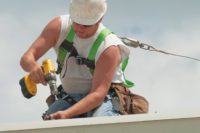4 hearing protection myths


1. Myth: “Use of hearing protection makes communication difficult.â€
TRUTH: For individuals with normal hearing, use of HPDs may help provide improved communications when sound levels are greater than approximately 85 dBA. (Berger, 2010). This is due to the fact that, when exposed to high levels of noise, the ear becomes overloaded and sound is distorted, reducing the ability to accurately discriminate different sounds. The use of HPDs helps reduce sound levels, allowing the ear to operate more efficiently. This effect is similar to the use of sunglasses to help improve vision in very bright light, high glare conditions. It’s helpful to caution new HPD users that it may take a few days or weeks to adjust to hearing through HPDs.However, for individuals with moderate-to-severely- impaired hearing, the use of HPDs may decrease the ability to communicate effectively. In these cases, some improvement in communication may be possible when hearing protectors with uniform attenuation are worn. Flat or uniform-attenuating hearing protectors use mechanical means to filter the sound and provide nearly equal attenuation across the audible frequency range (OSHA 2005). HPDs with electronic speech enhancement capabilities may help as well.
In any case, the idea of going without HPDs in order to communicate better should be rejected. In addition to the overloading of the ears, described above, unprotected noise exposure is likely to result in NIHL which can cause even greater difficulty communicating regardless of the noise level.
2. Myth: “I have already lost some of my hearing; hearing protection won’t help me anymore.â€
TRUTH: The use of HPDs provides several benefits with respect to existing hearing loss. First, proper use of HPDs will help prevent individuals from developing temporary NIHL and may allow existing temporary hearing loss to recover before becoming permanent. Second, although use of HPDs cannot restore normal hearing, they may help prevent additional hearing loss. People with existing hearing loss are susceptible to additional NIHL. The progressive nature of NIHL is illustrated in Figure 1. Initially, hearing damage occurs at the higher frequencies. As the unprotected exposure continues, the damage and hearing loss spread to the lower frequencies. Eventually, most of the frequencies that are essential to understanding speech (500 Hz to approximately 3000 Hz) may be affected.
3. Myth: “Earmuffs block out more noise than earplugs.â€
TRUTH: Bigger is not necessarily better when it comes to hearing protection. Actually, the amount of sound blocked by HPDs depends not only on the NRR of the device but also on how well they fit the wearer, and how motivated he or she is to wear them correctly.In the laboratory, where HPDs are fit as well as possible, some earmuffs do outperform certain earplugs, but not in every case. Figure 2 shows the noise reduction (attenuation) measured in the laboratory of four commercially available HPDs (two plugs and two muffs); notice that earplug A outperformed the two earmuffs while earplug B did not.
However, in the workplace, earmuffs often do outperform earplugs. (Berger, 1993). This is likely related to the ease of fitting earmuffs correctly as compared to earplugs that must be carefully inserted into the ear canal for optimum noise reduction.
Keep in mind that other factors aside from attenuation need to be considered when selecting a HPD. For example, comfort and the suitability of the HPDs for the intended application can affect how well HPDs are worn in a particular application.
4. Myth: “I will hurt my ears if I blow my nose while wearing earplugs.â€
TRUTH: No. Wearing earplugs is not likely to have an affect on pressure changes in the middle ear related to blowing your nose. (Berger, 1982). This is because the earplug is inserted into the external ear canal which is separated from the middle ear by the eardrum. However, even when a person has a perforated eardrum(s), earplug use is not likely to cause an increase in pain during nose blowing.References
Berger, E. H. (2010). Hearing Through the Protectors. Industrial Hygiene News. July/August 2010, Vol. 33 No. 4, 8 -14.Berger, E. H. (1993). E-A-RLOG 20—The Naked Truth About NRRs. Retrieved from www.e-a-r.com/hearingconservation Taylor, W., Pearson, J., Mair, A., and Burns, W. (1965). Study of Noise and Hearing in Jute Weaving. J. Acoust. Soc. Am., Vol. 38, 113-120.
U.S. Department of Labor. Occupational Safety and Health Administration. Hearing Conservation for the Hearing Impaired Worker. Washington, D.C. Safety and Health Information Bulletin 12-27-2005.
Looking for a reprint of this article?
From high-res PDFs to custom plaques, order your copy today!




